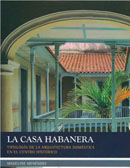The book entitled The Havana House: Typology of Housing Architecture in the Historic Center by Dr. Madeline Menendez, takes up a publishing slack about the studies –long on hold– in the field of Cuban architecture and, more specifically, the houses built on the island nation that largely make up the cities’ urban heritage.
The volume hinges on a well-documented research study conducted by the author in the course of several years for her doctoral thesis work at the School of Architecture of the University of Havana and whose end result has now seen the day of light with this publication.
An expert in the field of built heritage, the researcher delves into the different typological-architectural structures of historic Center houses and establishes a set of spatial family groups, the outcome of that “Cuban school of house building” addressed by masters Francisco Prat Puig and Joaquin Weiss in their monumental studies put out in the first half of the 20th century.
Laid out in four basic chapters, the book ranges from the meaningfulness of the architectural typological analysis and the repertoire of domestic houses that evolved in the course of the city’s five-century-old history, the presentation of the main thesis by defining a typological structure of Old Havana’s historic Center, to the culmination through an analysis of these houses’ current possibilities in terms of their capacity to be adapted to new urban functions without having to endure dramatic transformations –since they stand for valuable heritage elements. The volume also provides terminology and concepts, an architectural glossary and a list of specialized bibliography that sheds plentiful light on the subject matter and leads to better understanding of the essay.
From the moment the author writes in the foreword that “the rehabilitation of the historic Center could be an absurd purpose if it wouldn’t include, as a top priority, the conservation of that dominant compound that has been built,” in clear reference to housing architecture as “the finest qualifier of the different urban environments.” By doing this, she’s forewarning us about the impending need to execute plans for the safeguarding of great religious, public or military monuments.
And as part of the basic instruments that Dr. Menendez believes as “capable of orienting the decision-making process related to the future of these buildings and the way of undertaking the constructive interventions,” comes the typological clarification of the built heritage. And it’s precisely this categorization what actually “avoids traumatic and costly maneuverings in the long run”, let alone it “leads to superior faithfulness in terms of respect for heritage values of each and every one of these houses.”
There’s no doubt about the basic foundation in the presentation of this through study. The historic evolution is pretty well comprehended, that road of climatic adaptations, of access to local materials, the development of building techniques –either imported or vernacular– or by the hand of the impending needs of “the new requirements and intensities […] imposed by contemporariness and the difficult socio-economic circumstances” that come along in a chronic fashion, this Havana house from today and for always is finding itself threatened as if it were an endangered species without a lifeline to get by in coming times.
Put differently, this is nothing but a simple binary equation: either the centuries-old tradition is respected or the capacity of future evolution of the “Cuban house building school” is cut off for good in terms of constructing a sustainable habitat. I believe this is no doubt one of the main statements of the book that zeroes in on spatial distributiveness, assessing the variation and complex process of functions and rooms within a house –not that much from a mere formal expression but rather from the craftsmanship tradition of housing models and their contextual looks.
It’s a reality no one can hide, as the author puts it, that due to the drive of the refurbishment programs of the Historic Center –stepped up since 1994- prompts in some unhappy cases “[…] the promotion of actions that in their quest for profitability” –and urgency, I might add– “some programs imply the enhancement or subdivision of buildings” that are far graver and more complex in the houses. This is owed to the contradiction between the huge demand for housing spaces and the systematic lack of appropriate offers that eventually lead residents to coming up with –in many cases–“undesirable” interventions in their own houses.
In piecing together the theoretical discourse of the text, the researcher shows us in the first chapter (Typological Analysis of Architecture) an approach about the first interpretations of the architectural “type” and “typology” concepts that set out to give us a closer look at both the history and evolution of these categories harking back to the early 19th century. And this is done on the basis of different analyses on two outstanding French theoreticians: Quatremère de Quincy and Jean Nicole L. Durand.
The author writes that Quincy offers the first formulation “about the idea of the type applied in architecture” based on the “relationship between the object’s shape and nature, while he warns about “the importance of not confusing the type with the model” (“something to copy […] or imitate”), while the type “constitutes the element that will serve the rule.” According to this author, architects “rely on those models that history has legitimized” that, construed in the practice of art (also the architectural art) “is an object that must be repeated per se; the type, on the contrary, is an object from which works that don’t take after one another can be conceived.”
For his part, Durand, the other father of architectural typological studies, provides “a catalog of component elements in any architectural work that comes along with instructions about its use, aimed at achieving convenient and economical compositions”.
Menendez points out that would have those foundational analyses not been learned, barely no interpretations of those monumental works from the past would have been made for the sake of the reconstruction of European cities devastated by two world wars. Or perhaps more recently, the 1964 Venice Chart would have never upheld the protection of urban compounds in which the simple, traditional urban housing acquired from that moment on the right to be valued and, consequently, preserved.
In this first chapter she peruses the international vision on that topic in the light of the 20th century through the ideas of Gustavo Giovanonni in the Restoration Chart (or the 1931 Athens Chart), running through the advanced French and Italian legislations in that same field all the way to the Italian initiatives of the 1960 for the safeguarding of historic cities. Lastly, there’s clear evidence of the Cuban experience in the theoretical studies and their practical application that come to a close with the principles and approaches undertaken in Old Havana, studies that the author chips in as new contributions to ease “a practical response management to the dynamics of the Historic Center”, and thus avoid new uses and their consequent constructive actions of remodeling that could make a dent on the heritage values domestic housing boasts.
In the second chapter entitled “Housing Architecture in Old Havana”, the author conducts a thorough study –decked out with plentiful documental contributions– of type houses in which, departing from land lot intensity (built land average), she identifies the different houses that were built in types: the so-called low rises and the high rises (mostly for just one family); the multifamily houses, including condominiums and apartment buildings, tenancy housing (for rent) and mixed buildings that combined commercial purposes on the lower floors and housing on the upper floors. All of them popped up in a progressively as Old Havana developed into a far more complex residential area.
In the third chapter, “Housing Architecture Typological Structure in the Historic Center”, and based on an analytical procedure layout, she turns to –among others– the following elements to label housing architecture in the old part of town: the house’s initial purpose (for one family, multifamily and mixed), the width of the land lot, the locales in the first set of rooms on the bottom floor, the floors, the staircase position, the kinds of openings, as well as the position and types of patios and backyards. In my own judgment, the truly substantial contribution lies in the conformation of the typological structure in which different layouts, definitions and characteristics of each and every one of them become vastly useful findings.
The fourth and last chapter, “Usage Possibilities of Buildings”, pans out to be a quasi-normative instrument to encourage better use of inner spaces in both current houses and buildings. The formulation of a chart of permissible and impermissible usages for each housing typology establishes an irreplaceable guideline for neighbors, architects and developers, as well as urban management authorities when coping with different renovation and refurbishment programs of sectors and barrios in Old Havana.
The study traces the periods of the Havana house from the simple hallway low-rise with corridors and patios that grew in complexity as it evolved, owed among other factors to the owner’s purchasing power or his position in the block –on a corner or in the middle. She then looks into the house of two or more stories, many of them were dwelt by well-off Spanish and Cuban families during the centuries of the colonial rule –the most distinguished ones were called ancestral– in which the number of family members and the stock of slaves led them to building notable façades, ample corridors, mezzanines, stables, warehouses, noble floors with spacious halls, accessories and even porches –if the houses were located across a square. She goes on with the mixed buildings and apartment houses and buildings that became so commonplace in the 20th century.
The development of this Havana house –from the old inside-the-walls sector that years later stretched out beyond those walls– let go of such basic typological elements as patios, backyards, hallways, porches, gables and upper rooms, among others. Likewise, this kind of house came up not only with a new concept in terms of intra-family and social life, but it also fell prey of speculation, technological breakthroughs in building, the copycatting of foreign models1 and other elements that played a role in what some authors call “the habitat social production”.
I’d dare suggest researchers in this field to study other houses in Havana, like the popular vernacular houses of the outskirts, the eclectic bourgeois houses of El Vedado and La Vibora, the house that marked the hatching of Cuban architecture’s modern movement in the west side neighborhoods, and many others. In the same breath, it would be very encouraging to take a look at houses in other parts of the Caribbean that, we all know, established a relationship with those cultures that developed on its sidelines as it happened in south Florida, settlements in the Gulf of Mexico’s basin and Central America, the West Indies and the northern South American region comprising Colombia and Venezuela.
In three Caribbean contexts colonized by the Spaniards: Campeche, in Mexico; Santo Domingo, in the Dominican Republic, and La Pastora in Caracas, Venezuela, for instance, I might venture to find some similar answers in their traditional houses, especially during the 18th, 19th and the early 20th centuries.
Common elements like humid tropical weather conditions, abundance of red clay and natural limestone, hardwood in the nearby forests, the origin of many of their builders and first neighbors, the models that inspired that kind of construction, the adaptation of the settlement areas, many of the building techniques and systems used in the constructive process, the wood for the roofs, the windows, the balconies, the patios and the endings of the houses speak volumes of similarities rather than differences.
However, there are some evident inequalities in Campeche, where the stone arches are generally lower than those in Havana houses of central patios, or in Santo Domingo, where some houses feature balconies that overlook the patio, or the houses in the so-called La Pastora Traditional Center, in northwest Caracas, perched on a highly rugged terrain hedged by crags and whose humble doorways are marked by short double-door hallways that make them far safer.
The arrival of this small gem on Havana housing –it won the 2009 Literary Review Prize– is quite a feather in the Boloña Publishing House’s cap, a label that since its foundation has set out to support through its different volumes the huge refurbishment works conducted by the Havana City’s Historian Office, a continuation of that office set up by Emilito Roig and that from 1938 to 1958 churned out so many books, news articles and compilations on the history of Havana, its traditions and customs. The Master Plan by the hand of its Arcos Collection, has helped put out this research study that boasts a thorough editing, a nice-looking design and a digital compilation.
The Havana house, or better yet, the house of old and colonial Havana that sprawled by the Carenas Bay some 490 years ago, has this time around deserved a scientific look, the upshot of the author’s maturity and dedication that has given us a substantial array of studies on Cuban architecture and that will surely have a continuation in coming generations of scholars who deal with Cuba’s material culture.



















